Products You May Like
Get full access to Outside Learn, our online education hub featuring in-depth fitness, nutrition, and adventure courses and more than 2,000 instructional videos when you sign up for Outside+
Sign up for Outside+ today.
Every man thinks he’s just a “shell guy” until he actually tries an insulated ski jacket that’s as weatherproof as his favorite Gore-Tex shell, as breathable as it is warm, and not as bulky as he thought. Our favorite resort jackets of the year for men come in all shapes, sizes, fabrics, and insulation levels, so all you have to do is decide what’s most important to you while skiing bell to bell at the resort.
Need something that will keep you warm and dry while waiting for first chairs and rope drops? Scan this list for insulated pieces our testers loved for their warmth. Just getting chairlift bumps to access the hike-to-terrain? You probably want something highly breathable, packable, and with little to no insulation, like the four shells included on this list. Whatever you decide, you can’t go wrong with these high-tech, bomber jackets that were designed to weather any day at the resort.
Also read: The best men’s ski pants of the year
How We Test
Number of jackets tested: 25
Number of testers: 10
Average age, height, weight of testers: 32, 6”, 175 lbs
Number of après beers spilled on jackets: 3
Our testing began in what may seem an unlikely location: on an island in the Pacific. But the mountains of Vancouver Island are actually ideal testing grounds: It’s often stormy and mild, perfect for testing gear’s weather resistance. After a good soaking, we sent most of the jackets to testers in colder and dryer ski zones, including the Canadian Rockiers, Whistler-Blackcomb, Sun Valley, Tahoe, and Vermont.
Our main goal was to get quality feedback from a group of diverse testers, testing in a variety of conditions. To that end our testers ranged from teenage rippers to veteran weekend warriors to ski bums who stretch their season as long as possible. Our test group spends an average of 40 days on snow per year, so you can trust they know what matters in a quality ski jacket. The jackets on this list made the cut after impressing testers most with their weatherproofing, breathability, fit, comfort, and style.
Reviews: The Best Men’s Ski Jackets of 2023
Picture Organic Stone Jacket ($330)
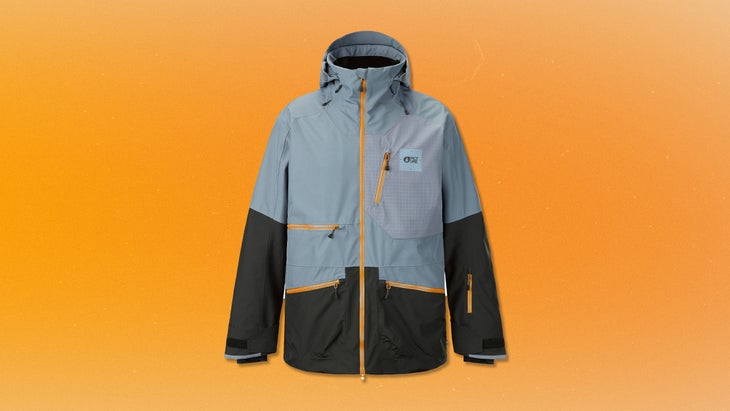
Sizes: XS to XXL
Weight: 2.9 lbs
Insulation: Yes
Price: $330
Pros: Accommodates a big temperature range; eco-friendly
Cons: Heavy and bulky; trendy look not for everyone
“Stay awhile!” It was a lame joke aimed at tester Adam Jaber’s delayed jacket-shedding, but it speaks volumes about this insulated coat’s incredible thermoregulating ability. Picture lined the waterproof polyester shell (made from a blend of sugarcane waste and recycled content) with 180 grams of fleece-like liner in the body and arms and a honeycomb of loosely woven fabric down the spine. The latter helped keep sweaty back to a minimum. Testers stayed happy skiing everything from 15 degree-days and stormy conditions to spring corn and, in Jaber’s case, hanging inside the lodge. “It is impressive,” he noted. “I’m normally a shell guy, but I actually loved this jacket.” Pit zips and a fleecy high collar help find the sweet spot without de-layering. For places with big temperature variations, we don’t know of a jacket that will keep you more comfortable.
Quiksilver Black Alder Stretch Jacket ($420)
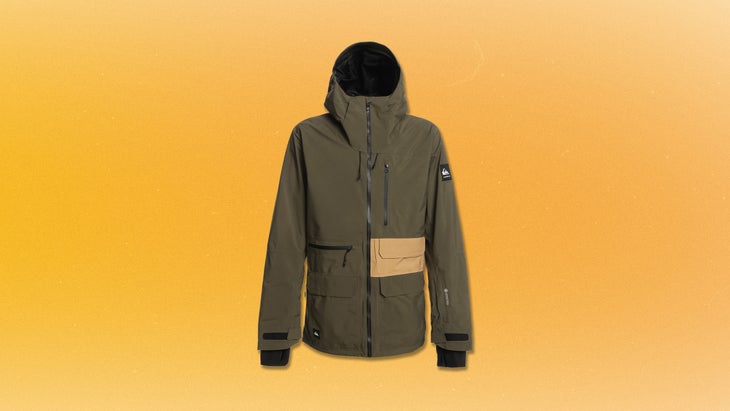
Sizes: XS to XL
Weights: 2.3 lbs
Insulation: No
Pros: Good fit; moves with you
Cons: Too many pockets; too warm for hiking
If comfort is king, this jacket is Elvis and Kondo wrapped into one. The stretchy, two-layer Gore-Tex fabric is velvety on the outside and fleecy on the inside. Zipped right up, the collar is cozy and the hood cavernous, perfect for hunkering through windy chairlift rides. The thumb loops add warmth on a chilly day and keep the snow out. Tester Paul Marshall, who skied in the Black Alder at Sun Valley, Idaho, in a mix of winter and spring conditions, said the jacket, lightly insulated throughout, was just right for most temperatures. The pocket critic in him, however, had a mixed reaction. The pockets hide their loads well and never look stuffed, but there are just too many of them: twin hand warmers, media, pass, goggle… “Pockets layered on pockets,” Marshall reported. “It just got confusing as to where I put things.” If you can get over the pocket overload, this jacket sports a great fit and feel.
Helly Hansen Swift Infinity Jacket ($500)
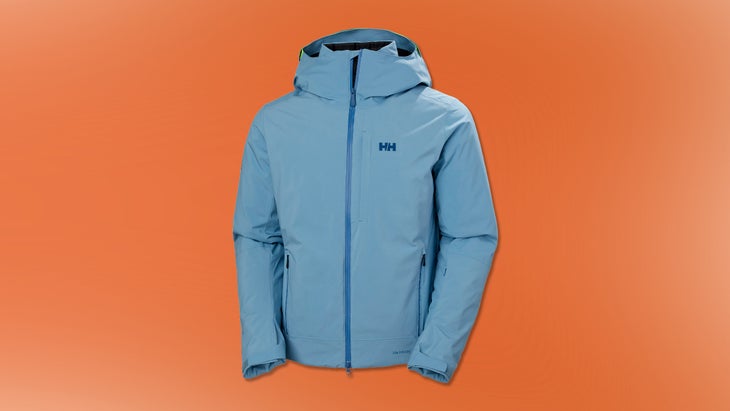
Sizes: S to XXL
Weight: 1.9 lbs
Insulation: Yes
Pros: Eco-friendly; very warm
Cons: Fits short; too warm for milder weather
It’s the little things that propelled this jacket from good to great. Let’s start with the hood and collar. Instead of being integrated, the two operate separately, which actually improves both. “Zipping up the fleece-lined collar creates a cocoon around my face,” noted tester Derek Stuart. That was perfect for protecting against the minus-20-degree-Fahrenheit cold he experienced at Lake Louise, Alberta, especially since there’s plenty of room at the collar for a neck gaiter. When the wind blew, Stuart could hoist the hood over his helmet without having to drop the collar first, and a single pull cinched it nice and snug. The PrimaLoft Black Eco insulation throughout the jacket kept him toasty, and, on a warmer day, the mesh-backed armpit vents allowed him to cool off without risking a snow shower if he fell. The cuffs happily sync with gaitered or gauntlet-style gloves. It’s a good pick for chilly areas or skiers who run cold. Note: The short, tailored style fits a bit small.
Black Crows Ora Xpore Section Jacket ($840)
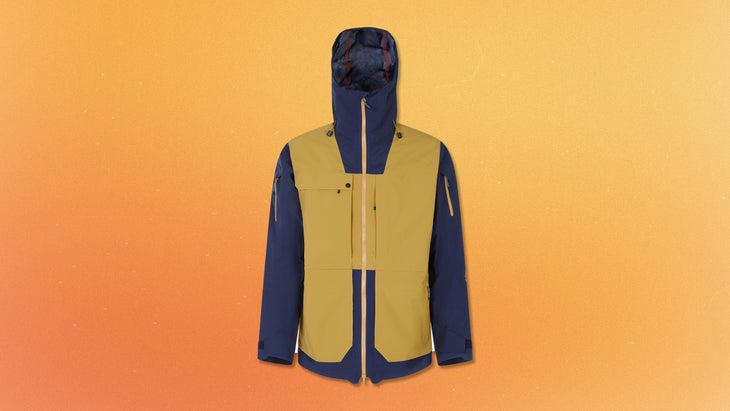
Sizes: S to XL
Weight: 1.8 lbs
Insulation: No
Pros: Good weather protection; stylish
Cons: Expensive; bulky for a shell
The uninsulated Ora helped tester Chris Baikie put to rest any worries about navigating Whistler Blackcomb during a Coast Mountains storm. “The thick material feels like armor,” he commented. “It inspires confidence.” At the heart of the protection is Xpore, Black Crows’ new membrane, which boasts a waterproof test result that the brand claims is 50 percent better than many top jackets. Combined with waterproof zippers, the Section remains dry in a melt-on-impact sleet storms that leave other jackets soaked through. And it breathes better than most: “I didn’t need to crack the pit zips on a bootpack, like I usually do,” Baikie said. He and other testers liked all the pockets and pouches, which fit extra gloves, a lens, a mask, a phone, a wallet, and water without feeling overstuffed. At 1.8 pounds, it’s not a light shell, but testers didn’t notice the extra heft. We chalk that up to a great fit with a touch of style—check out that swallowtail.
Columbia Platinum Peak 3L Jacket ($300)
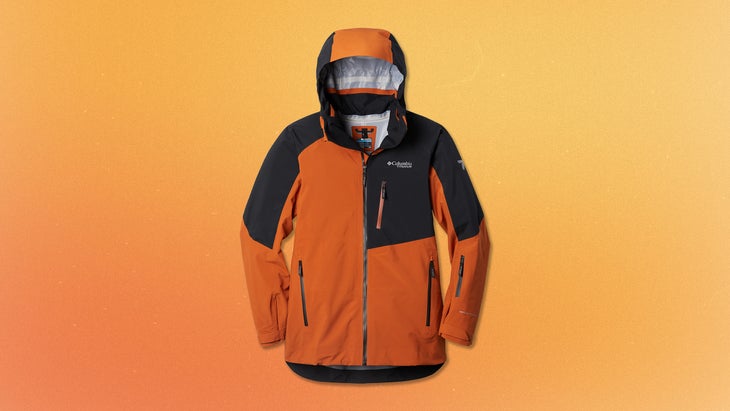
Sizes: S to XXL
Weight: 1.6 lbs
Insulation: No
Pros: Affordable; packable
Cons: Runs large; finishing touches not very refined
We see a lot of value in this jacket and its matching pants. The simple, uninsulated design still has all the features we look for in a ski shell: pass pocket, adjustable cuffs, helmet-friendly hood, powder skirt, and long tail for soggy chairlift rides. It also has some nice touches we usually see only on pricier jackets; a fleece patch at the chin was “nice to tuck into on the chair,” reported tester Liam Sjogren. There are just enough pockets, and they sit out of the way of pack straps. The stretchy three-layer construction is dependably waterproof, which is not always the case. And the Platinum Peak has great ventilation, thanks to its combo of breathability and pit zips. Sjogren usually works up a sweat lapping Whistler’s Peak Chair, but didn’t in this jacket. Watch the sizing, though: The medium fits like a large. Otherwise, this is a solid budget pick that skis like a premium shell.
Candide C2 Jacket 3L ($1,099)
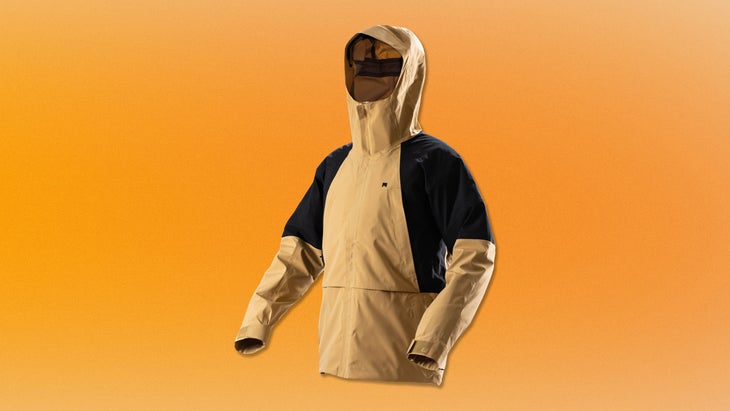
Sizes: XXS to XXL
Weight: 3 lbs
Insulation: Yes (removable puffy)
Pros: Attractive design; two jackets in one
Cons: Expensive; bulky collar
That’s no typo: This is a $1,000-plus jacket. For the right skier, we think it’s worth it. First, unlike most two-in-one jackets, which trend toward the lower end in terms of quality, this puffy-and-shell combo is stacked with premium technology. The removable puffy is stuffed with PrimaLoft ThermoPlume insulation, a recycled fiber that mimics the performance of down while retaining synthetic’s easy maintenance. Meanwhile, the three-layer hooded shell is bomber. It uses a recycled polyester and bio-based material derived from sugarcane waste and recycled plastic, treated with a PFC-free DWR coating. It feels soft and stretchy and kept tester James Sjogren cozy when the Peak Chair stalled on a stormy day at Whistler. “I ducked into the high neck and stayed warm,” he reported. He found the same collar a little obstructive when skiing, though other testers didn’t. Everyone loved the look, which is as slick and stylish as the company’s founder and namesake, Candide Thovex. If you’re buying a shell and puffy anyway, this is a pretty deadly combo.
Sponsor Content
Columbia Platinum Peak Hooded Jacket ($180)
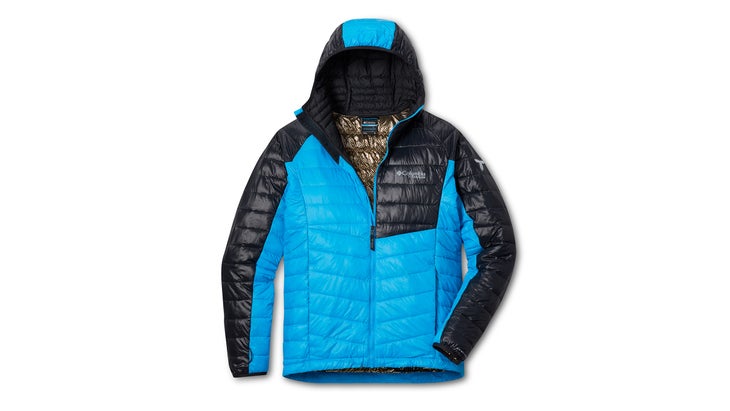
Do you want to extend your time on the slopes this season? Then you’ve got to stay warm. Luckily, Columbia has your ticket to comfort and warmth on and off the mountain. The Platinum Peak Hooded Jacket from Columbia retains body heat without sacrificing breathability thanks to Omni-Heat Infinity advanced thermal reflective technology. The jacket’s recycled synthetic down provides comfy, warm insulation, and the multiple zippered pockets keep your essentials safe in all conditions.
Eddie Bauer Night Ski Down Jacket ($299)
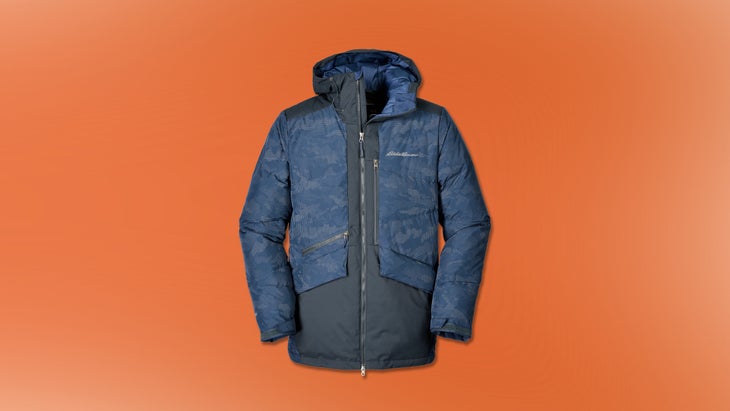
Sizes: S to XXL (also available in tall sizes)
Weights: 2.5 lbs
Insulation: Yes
Pros: Lots of storage; very warm
Con: Bulky; small hood
It didn’t matter what the thermometer said, we were always cold night skiing—until we put on this downy palace. By stuffing 650-fill sustainable down from the below-the-butt hemline up to the hood, Eddie Bauer created a refuge that allows us to spin nocturnal laps until the lights went out. And the weather-resistant polyester ripstop shell has a reflective print that adds visibility. But this is no one-trick night owl. With seven pockets, including two big interior mesh sleeves, tester Ryan Stuart could load up for a day on the hill and never come in for a warmup. “I never felt the need to double up. It’s just that warm,” Stuart said. “It’s like a great big warm hug and a backpack all in one.” He did notice, however, that only low-profile helmets fit under the hood.
Marmot Refuge Pro Jacket ($425)
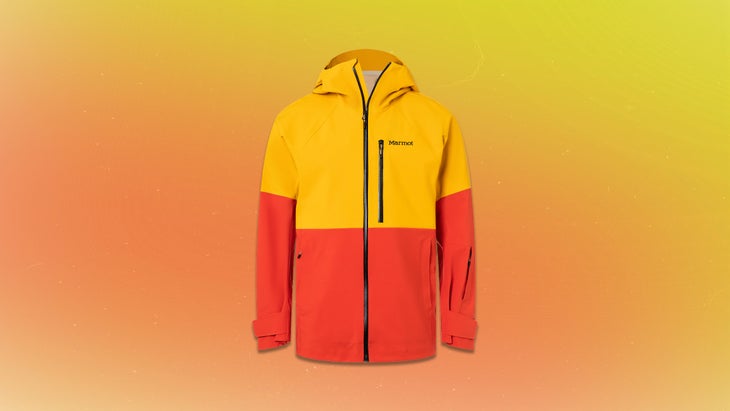
Sizes: Men’s S to XXL
Weights: 1.8 lbs
Insulation: No
Pros: Versatile; breathable
Cons: Attracts dirt
Marmot calls this a backcountry shell, and there’s no doubt it can handle the skintrack, but with a powder skirt and pass pocket, the Refuge Pro suited warm-blooded testers just fine for resort laps. Paul LaPerriere found that the stretchy fabric and articulated tailoring moved with him and, combined with Marmot’s proprietary membrane, was breathable enough that he didn’t overheat. “I’m usually cracking zippers, but wasn’t in the Refuge,” he noted. The jacket also comes by its name honestly: The Refuge didn’t wet out on a soggy powder day, and a single pull snugged the hood around a helmet during an Arctic outflow, leaving just a goggles-sized opening. Our one knock: The bright color scheme attracts dirt as much as the eye. In our opinion, it’s a small price to pay for one jacket that’s just as happy in the resort as out of it.
Stio Environ XT Jacket ($445)
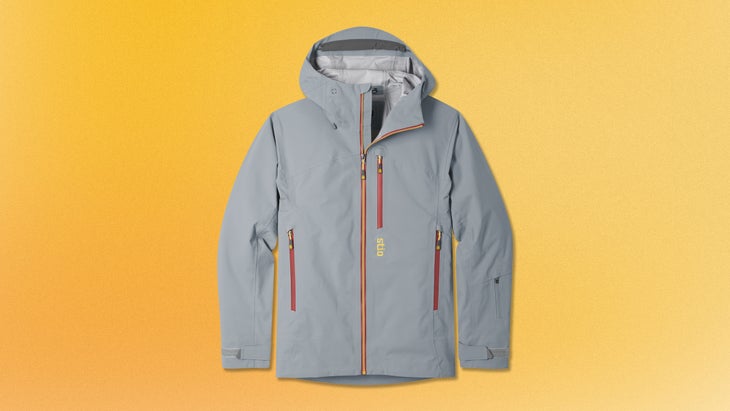
Sizes: Men’s S to XXL
Weights: 1.5 lbs
Insulation: No
Pros: Eco-friendly; durable
Cons: No powder skirt; limited adjustment on cuffs
The Environs XT was already one of Stio’s most popular jackets, even before they made it better by paring it down, swapping in 100-percent-recycled polyester face fabric, and adding a zippered pass pocket on the sleeve and glove-friendly tabs on the cuff closures. The resulting jacket is a bomber shell that shielded tester Ryan Stuart through back-to-back storm-skiing days at Mt. Washington on Vancouver Island. “It was wet out, but I never was,” he said. What stood out was the attention to detail: oversized zippered hand pockets that play nicely with backpack straps, extra storage inside the jacket (zip pocket on one side, mesh sleeve on the other), oversized zipper pulls, and just the right amount of room for layering. There’s no powder skirt, so we recommend pairing it with bibs, such as Stio’s Enviro Bibs. “The designers nailed the line between minimalism and fully featured,” noted Stuart. “For skiers who prefer skiing in a shell, this is a solid choice.”
Maloja HallimaschM. Jacket ($419)
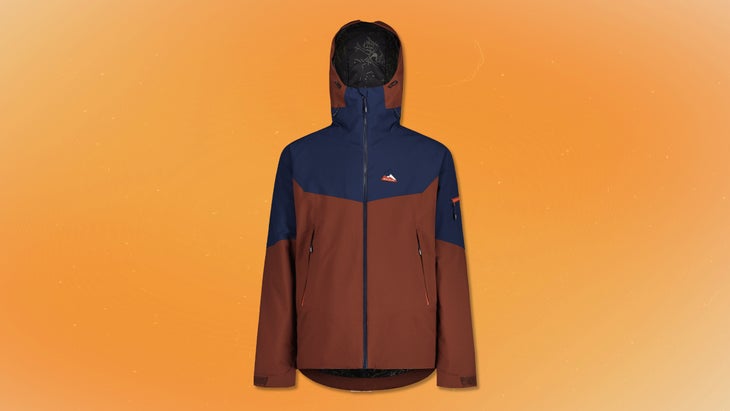
Sizes: Men’s XS to XXL
Weights: 1.8 lbs
Insulation: Yes
Pros: Versatile amount of insulation; approachable style
Cons: Not very waterproof; hard to find in U.S. stores
We like that the founders of Maloja named the brand after a one-lift ski hill in the Swiss Alps. As for why they called this jacket “honey fungus,” a mushroom delicacy in their Swiss homeland, we’re less sure. At least the lightly insulated shell makes sense. It’s made with a recycled protective face fabric that is stretchy, breathable and highly water-repellent, 60 grams of PrimaLoft biodegradable synthetic insulation, and a soft interior lining. Tester Derek Stuart wore this jacket over a base layer and a sweater, and it was just right for a minus-10-degree-Fahrenheit day at Alberta’s Lake Louise. Atop just a T-shirt, it was good for a 40-degree day at Northstar, and the lining stayed dry even when another tester got a bit sweaty. We found the slightly relaxed design fit a variety of body shapes well, with room for adjusting layers, thanks to a bit of stretch. The brand might be hard to find at stores, but we think it’s worth hunting for. Ah! Now we get the mushroom homage.
More 2023 Gear Reviews
The best all-mountain skis of 2023
The best high-performance alpine boots of the year
The best goggles of 2023
